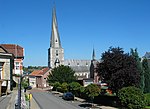The Duchy of Limburg or Limbourg was an imperial estate of the Holy Roman Empire. Much of the area of the duchy is today located within Liège Province of Belgium, with a small portion in the municipality of Voeren, an exclave of the neighbouring Limburg Province. Its chief town was Limbourg-sur-Vesdre, in today's Liège Province.
The Duchy evolved from a county which was first assembled under the lordship of a junior member of the House of Ardenne–Luxembourg, Frederick. He and his successors built and apparently named the fortified town which the county, and later the Duchy, were named after. Despite being a younger son, Frederick had a successful career and also became Duke of Lower Lotharingia in 1046. Lordship of this county was not originally automatically linked with possession of a ducal title (Herzog in German, Hertog in Dutch), and the same title also eventually contested by counts of Brabant, leading to the invention of two new Ducal titles: Brabant and Limbourg.
The extinction of the line of Frederick's grandson Henry in 1283 sparked the War of the Limburg Succession, whereafter Limburg was ruled by the Dukes of Brabant in personal union, eventually being grouped together with the Brabantian "Overmaas" territories bordering it (including Dalhem, Valkenburg, and 's-Hertogenrade), to be one of the Seventeen Provinces of the Burgundian Netherlands. Unlike other parts of this province, the lands of the duchy stayed intact within the Southern Netherlands, under Habsburg control, after the divisions caused by the Eighty Years' War and the War of the Spanish Succession. However finally, after the failed Brabant Revolution in 1789, the duchy's history was terminated with the occupation by French Revolutionary troops in 1793. The easternmost lands were reunited within modern Belgium only after World War I.
The duchy was multilingual, being the place where Dutch, French, and German dialects border upon each other and coexist at their geographical extremes, both now and in medieval times. Its northern and eastern borders are the approximate boundaries of the modern state of Belgium with the Netherlands and Germany, at their "tripoint". The eastern part, which includes Eupen, is the administrative capital and northernmost part of the modern German-speaking Community of Belgium. The Duchy also included the main part of the Pays de Herve, famous for its pungent-smelling soft cheese known as Limburger or Herve.








